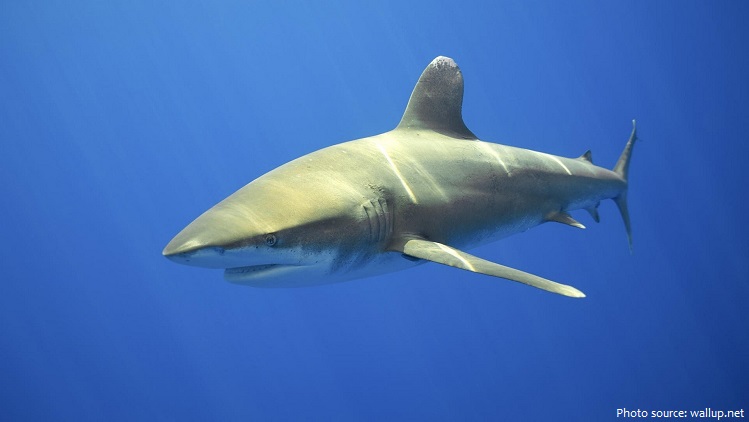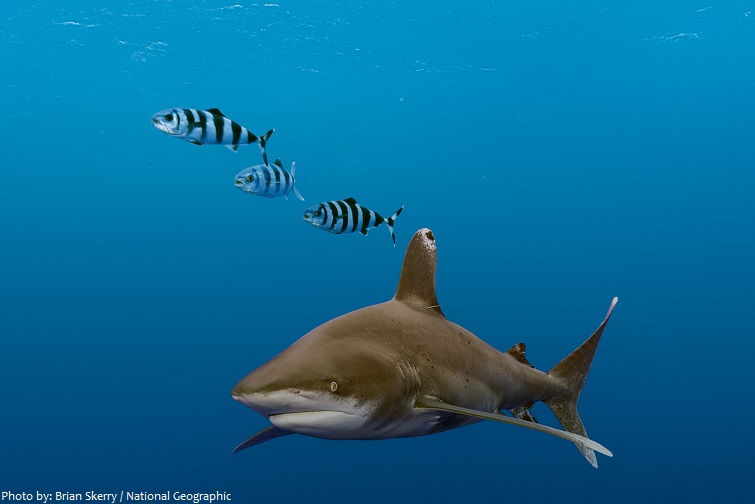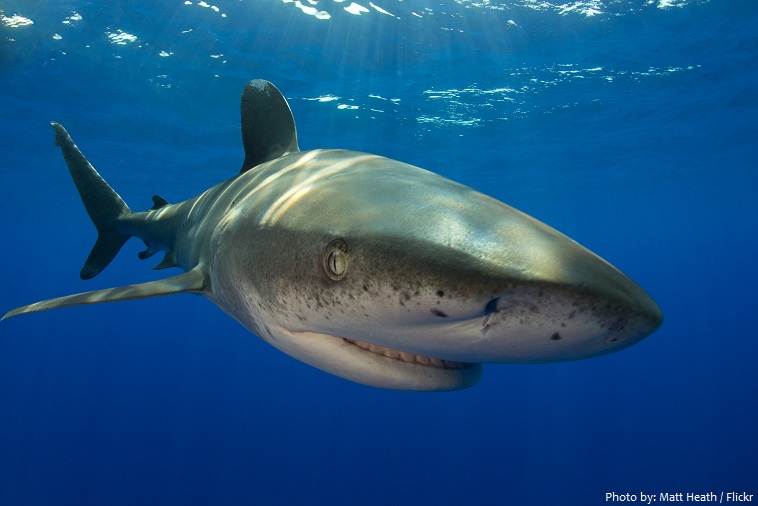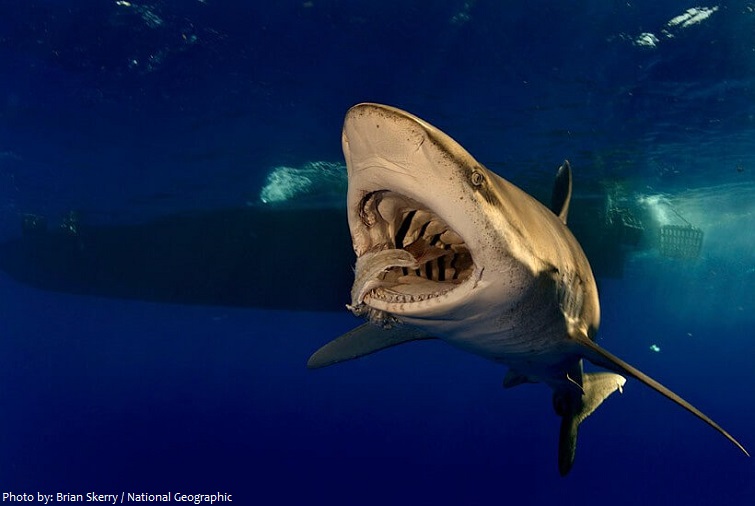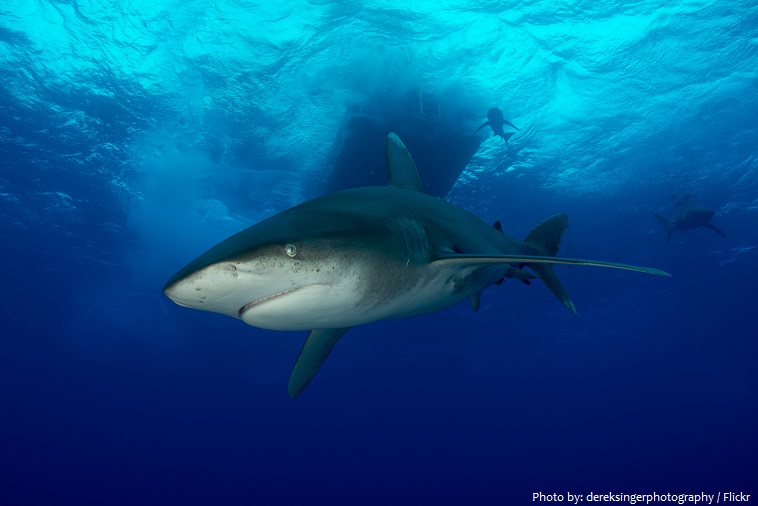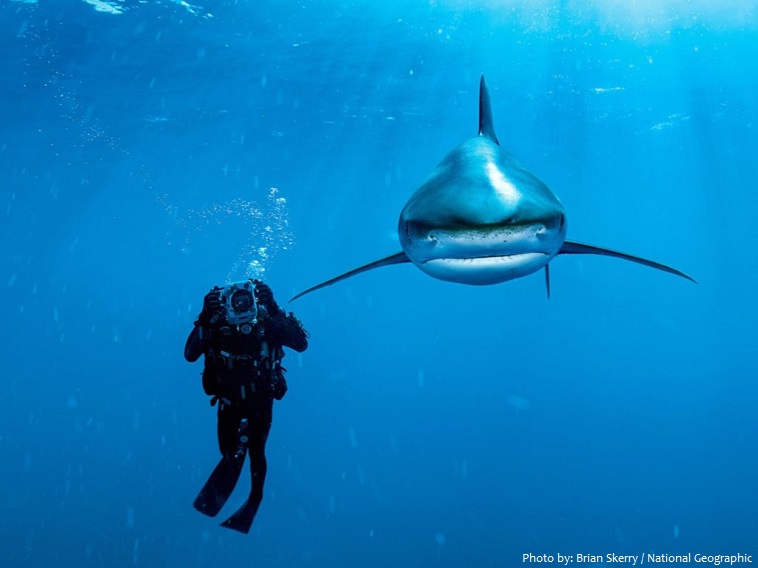The oceanic whitetip shark (Carcharhinus longimanus) is one of the most widely ranging sharks, common throughout the warm latitudes of all oceans.
It is a pelagic species that lives near the surface in warm waters (usually over 20°C (68°F)) in the open ocean, usually well offshore.
Oceanic whitetip sharks belong to one of the most popular shark families: the requiem sharks; and is
the member of the genus Carcharhinus.
The oceanic whitetip shark is so named because the tips of its pectoral, first dorsal, pelvic, and caudal fins are often white or show white mottling.
The dorsal side of their body can be a brown, grey, or grey-bronze color and the underside is white. This specific coloration creates a countershading effect. Countershading helps to blend into their surroundings and not to be detected by their potential prey.
The oceanic whitetip shark has a stocky build, a short, bluntly-rounded snout, and incredibly powerful jaws.
The largest specimen ever caught measured 4 meters (13 feet), an exceptionally large size considering few specimens are known to exceed a length of 3 meters (9.8 feet). The maximum reported weight is 170 kilograms (370 pounds). Females are generally bigger than males.
Oceanic whitetip sharks mature between 6 or 7 years of age and their lifespan in the wild can reach 15 years. However, the longest known lifespan recorded in the wild is 22 years.
This sharks are usually solitary and tends to cruise near the top of the water column, covering vast stretches of empty water scanning for possible food sources.
Oceanic whitetip sharks are relatively slow swimmers, but are capable of surprising bursts of speed. They are aggressive and persistent sharks and have shown little fear when confronted.
This slow-moving but aggressive fish dominates feeding frenzies, and is a danger to shipwreck or air crash survivors.
The oceanic whitetip shark feeds mainly on pelagic cephalopods and bony fish. However, its diet can be far more varied and less selective—it is known to eat threadfins, stingrays, sea turtles, birds, gastropods, crustaceans, and mammalian carrion. The bony fish it feeds on include lancetfish, oarfish, barracuda, jacks, dolphinfish, marlin, tuna, and mackerel.
This voracious predator grips is prey with the pointed teeth of the lower jaw, serrated only at the tip, while the broader, triangular, serrated teeth in the upper jaw are used to saw, cut and tear the flesh.
This species occasionally hunts in groups, helping one another to catch schools of fish. These sharks are fast-moving and competitive over food.
Mating season is in early summer in the northwest Atlantic Ocean and southwest Indian Ocean, although females captured in the Pacific have been found with embryos year round, suggesting a longer mating season there.
Oceanic whitetip sharks are viviparous marine animals which born baby sharks, or pups, in much the same way as human beings and other mammals. After gestating for 12 months, a oceanic whitetip shark may give birth to 1 to 15 live young. They are born fully developed, about 60 cm (24 in) long and ready to look after itself.
Newborns have black fin pigmentation, while the first dorsal fin has a tan or light brown tip. Generally, the newborns have black pigmentation on the fins, but eventually the black pigmentation fades into the shark’s natural white color on the tips of the fin.
The oceanic whitetip is a commercially important species for its fins, meat, and oil. It is eaten fresh, smoked, dried, and salted and its hide is used for leather. It is subject to fishing pressure throughout virtually its whole range —a lthough it is more often taken as bycatch than by design, since it is drawn to longline bait that is intended for other species.
IUCN classifies the oceanic whitetip shark as Vulnerable globally, with Northwest and Western Central Atlantic population considered Critically Endangered.
Famed oceanographic researcher Jacques Cousteau described the oceanic whitetip as “the most dangerous of all sharks”. Despite the greater notoriety of the great white shark and other sharks habitually found nearer the shore, the oceanic whitetip is suspected to be responsible for many fatal shark bites on humans, as a result of predation on survivors of shipwrecks or downed aircraft.
One of the most famous and deadly shipwreck-and-shark incidents features the oceanic whitetip. During World War II, the British troopship HMS Nova Scotia was sunk by torpedoes from a German submarine off the coast of South Africa, casting about 900 people into the shark-infested waters. Hundreds died, many from drowning and exposure, but oceanic whitetip sharks too lives as well.
Other common names for this species include Brown Milbert’s sand bar shark, brown shark, nigano shark, oceanic white-tipped whaler, and silvertip shark.
Among the oceanic whitetip’s most notable “cousins” are the spinner shark, bull shark, bronze whaler, dusky shark, silky shark and tiger shark.
